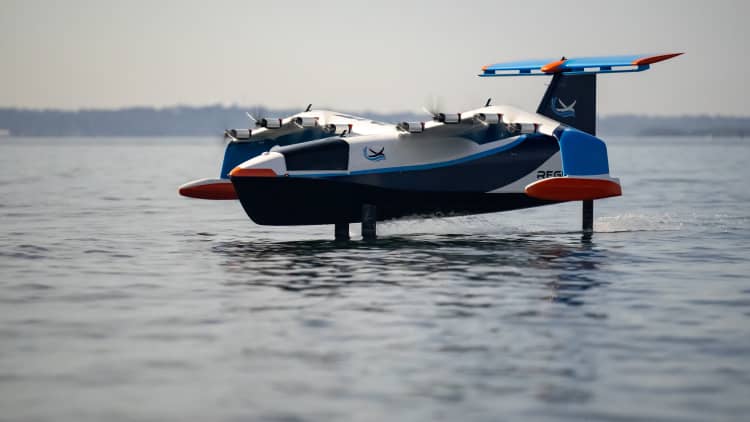Regent, a startup developing electric seagliders to transport people and cargo, has raised a $60 million round of venture funding and struck a partnership with Japan Airlines to figure out how to bring the company's flying electric ferries to the waterways of Japan.
Venture fund 8090 Industries co-led Regent's series A round alongside Peter Thiel's Founders Fund, with Japan Airlines Innovation Fund and Point72 Ventures also participating among others. The new funding brings Regent's total capital raised to $90 million to-date, according to co-founder and CEO Billy Thalheimer.
The funding follows two major milestones for the clean transportation startup. As CNBC previously reported, Regent built a quarter-scale prototype and completed a series of test runs on Rhode Island's Narragansett Bay late last year to prove that its seagliders, which are technically known as wing-in-ground-effect craft (WIGs) can "float, foil and fly" as expected.
The prototype was able to repeatedly motor out of a harbor slowly, then launch from a speed of about 40 mph into the air, where it flew around 10 feet above the open ocean at a speed of approximately 50 mph in different, travel-safe weather conditions.
The commercial version of this battery powered 12-seater, named the Viceroy, will fly higher above the water at speeds of up to 180 mph, Thalheimer says. The battery that powers the Viceroy seaglider will have a range of about 180 miles.
More recently, Regent built a full-scale mockup of the Viceroy, and a "sim room" at its headquarters where visitors can sit in a mock cockpit, and virtually fly the seaglider over any chosen waterway. Thalheimer said, "You can build as many decks or pitches as you want but this is the experience that unlocks excitement."
Eventually, travelers should be able to go down to a dock and board Regent seagliders like they would a regular ferry or water taxi. Besides using these WIGs for travel in coastal communities, Regent plans to sell seagliders to organizations providing cargo transport, search and rescue, offshore logistics as well as security and defense services.
Airlines and ferry operators including Mesa Airlines, Brittany Ferries and FRS are among customers who have already signed deals to purchase Regent's seagliders. The company says it has orders for more than 500 seagliders representing some $8 billion in future revenue. Southern Airways is poised to take the first production Viceroy, which it plans to operate under their Mokulele Airlines brand. Mokulele currently operates inter-island routes throughout Hawaii.
Regent will use its new round of funding for hiring as well as building and testing full-scale prototypes of the Viceroy, along with all the safety systems required to run the seagliders with people on board, Thalheimer says.
The company already has 55 full-time employees, the CEO said, and has managed to attract talent from the likes of SpaceX and Bureau Veritas, an international regulator of ships and vessels.
Longer term, Regent is developing a 100-seat seaglider dubbed the Monarch which is in early design stages. Including regulatory approvals, the company expects its Viceroy 12-seat seagliders to be in production and in service within two to three years. It expects the larger Monarch seagliders to be in service by 2030.

8090 Industries general partner Rayyan Islam, who co-led the series A investment in Regent, told CNBC that his firm backed the startup because of the demand for its seagliders, and the early team's success in prototyping and proving the viability of the Viceroy.
Islam's firm sees a new industrial revolution underway, one in which every sector will need to pursue "decarbonization" in a way that makes good business sense. Regent's seagliders, the investor said, can eliminate much of the greenhouse gas emissions from short-haul flights in aviation, and other emissions from ferries and water taxis, which typically run on diesel while working alongside existing infrastructure.
Islam also envisions Regent seagliders carrying people and equipment to help build, monitor or maintain offshore energy developments, from aging oil rigs to massive wind turbines.


